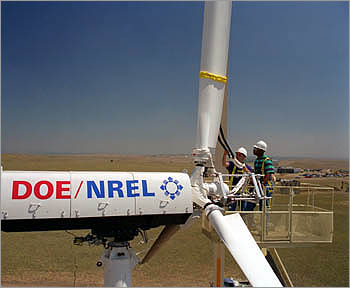One of the problems facing those who tout the hydrogen economy is developing an economic way to produce hydrogen in a usable form to power fuel cells and other clean power devices. The most obvious sources are coal, oil, natural gas, biomass, and water, but exploiting any one of those sources raises its own problems in terms of energy conversion and efficiency. However, US scientists are investigating the possibility of using another so-called green energy source to power the conversion of hydrogen without relying on the burning of fossil fuels – wind power.
About 95% of the hydrogen used today comes from natural gas. But the advent of hydrogen and fuel cell technologies for heating, power and transport, which could reduce global dependency on not unlimited oil reserves will require the winds of change to sweep the fossil fuel clouds away if the hydrogen economy is to prove a boon rather than lead to bust.

Researchers at NREL’s National Wind Technology Center are looking at ways to harness wind power to make hydrogen (Photo: NREL)
Some technologies, such as producing hydrogen directly from water using only sunlight, are ready for real-world demonstrations. Others are just emerging and will require long-term research and development investment. Researchers at the US National Renewable Energy Laboratory (NREL) are turning to wind turbines as another powerful alternative for generating the hydrogen economy. Wind power is already the lowest cost of any renewable energy technology, according to the NREL and might be adapted to hydrogen production.
If your goal is having as little environmental impact as possible, wind is a good way to ensure that, explains Bob Thresher, director of NREL’s National Wind Technology Center. There’s considerable promise in tapping the wind to make hydrogen, and then using that hydrogen in a fuel cell-powered car, for example. He points out that in the US, wind power is heading towards a cost of less than 3 cents per kilowatt-hour (kWh) and should reach that point within the next decade.
NREL researcher Lee Fingersh has completed preliminary studies in this area looking specifically at putative costs. The conclusion is that if you make electricity at the same time you make hydrogen, Fingersh explains, and store the electricity in batteries to maximize the efficiency of the process, you can make hydrogen pretty cheaply, on the order of $1.50 to $2.50 a kilogram. 1 kg of hydrogen is equivalent in energy to a gallon of petrol but given that hydrogen vehicles are expected to be two or three times as efficient as their petrol counterparts, the mileage would be even higher for a given cost.
A hydrogen system might also be useful in circumventing one of the obstacles to ubiquitous wind power: still days. When it is windy, a wind farm could generate electricity to power an electrolyser to split hydrogen from water, which could be stored for still days. However, Fingerish cautions that electrolysing units and fuel cells must become far more efficient to be economical in such a system.
Coupling the technologies could also reduce costs by precluding the need for certain electrical components. We’re looking at ways to potentially eliminate the need for certain electronic components, where we can make hydrogen directly from the current out of the turbine, Thresher says. He even suspects that the towers on which turbines are mounted someday may be modified to serve as storage tanks for hydrogen.
Further reading
Suggested searches
fuel cells